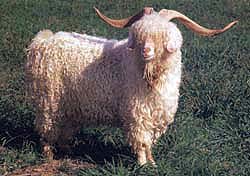
Goat breeds: Angora
Origin
Fleece-bearing goats have been raised in Asia Minor since the fifth century BC. Some were known for their long white fleece from which brilliantly dyed fabrics were woven. These were named Angoras because the best were raised in the province of Angora (now Ankara) on the central Anatolian Plains of Turkey.
This area, about 1000 metres above sea level, has hot, dry summers and cold, wet winters.
The first European record of the Angora dates from 1531 when the Dutch Ambassador, stationed at Constantinople, managed to secure a pair.
In 1820, the Sultan of Turkey allowed the export of raw mohair from Istanbul to Europe for the first time. The United Kingdom rapidly mastered techniques for spinning mohair and soon the demand for raw mohair was greater than Turkey could supply.
Angoras were first imported by the United States of America in 1849 when seven does and two bucks arrived in South Carolina.
History in Australia
In 1832, W. E. Riley of Raby, near Parramatta, purchased 13 Cashmere cross Angora goats from the herd of the Duchess de Berri of France.
Angoras were imported from Turkey in 1853 and later from South Africa and the United States. These animals went into many areas and numbers increased until the early 1900s when many flocks were dispersed.
Little interest was shown in Angora goats in the 1920s and 1930s and the population was reduced to virtually one flock in Victoria, owned by the Bartons.
Interest in the breed increased in the late 1960s and grew rapidly through the 1970s. There are now several thousand breeders of Angoras and the Australian flock numbers some 200 000.
Distribution
Vegetable fault, particularly burrs, reduces mohair value. As a result, Angoras are mainly found in the higher rainfall or grain-producing areas that are known as ‘free’ or ‘nearly free’ wool-growing districts.
Breed characteristics

Angora goats are white and have a single-coated fleece which is called mohair. The fleece grows continuously at a rate of about 2 to 2.5 cm per month. As textile mills require mohair up to 15 cm long it is usual to shear them twice each year. Fleece weights for mature Angoras vary from 1.2 to 2.5 kg, making the annual production about 2.4 to 5 kg per animal.
Angoras are ruminants; they have a slightly higher preference for woody plants than sheep do, and they use more browse—that is, the leaves of trees and shrubs.
They have a 149 day gestation with a marked autumn breeding season; bucks also show a pronounced increased sexual desire in autumn. They have high fecundity, with up to 70% of mature does having multiple births. This results in weaning rates of up to 160%, with the average being about 110%.
Uses

Angora goats are kept mainly to produce mohair which is used in the upholstery and apparel trades. Its particular characteristics are that it dyes to vibrant shades, retains its shape (memory), sheds dirt and imparts a ‘sheen’ onto finished articles.
Angoras also provide meat which has a ready market, both domestically and for export. In 1985, goat meat and related products were valued at about $8.8 million, of which the Angora is a minor but growing contributor, while mohair production was about 500 tonnes and was valued at about $5 million.
Further information
A register of stud Angora goats and their owners is maintained by Mohair Australia Ltd.
Acknowledgements
Assistance in preparing this Agfact was provided by Bruce Mannion, former Livestock Officer (Goats) Dubbo.

